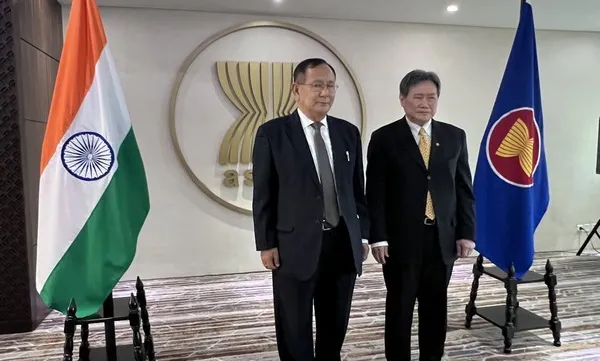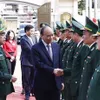India speeds up plans for shipping hub with connections to South-East Asia

Indian and Indonesian officials in a recent meeting agreed to “encourage sail tourism, cruise ship visits, and interaction between tour operators” between the two countries, against a backdrop of efforts to increase connectivity between the Andaman and Nicobar Islands and Aceh, where India is helping to develop the deep sea port of Sabang, according to The Star.
Officials from both countries also agreed to help create opportunities for investors.
Strengthening links between Andaman and Nicobar Islands and Aceh, 150km apart, is part of the Shared Vision for Maritime Cooperation in the Indo-Pacific signed in 2018 between the two countries.
“The broader context (of this cooperation) is closer political and economic ties. The idea is that there should be deeper and closer cooperation, and for that, infrastructure should be in place,” said Rajiv Bhatia, retired Indian ambassador and Distinguished Fellow at Gateway House, a think-tank.
The government’s ambitious infrastructure plan includes a leisure zone, a film city, a residential district and a tourism-specific economic zone, underwater resorts and beach hotels in Little Andaman, an island of about 707sq km.
But the biggest infrastructure push is coming in the largest of the Nicobar Islands, the 921-sq-km Great Nicobar, sparsely populated but rich in biodiversity. New Delhi is going ahead with plans to build a deep-berth port with a container transshipment terminal, an airport, power plant and township at an estimated cost of 720 billion rupees (S$11.7 billion).
According to a Home Ministry letter in March 2022, the airport will be a joint military-civil, dual-use airport under the operational control of the Indian Navy.
New Delhi’s plan is to create a transshipment port that will help India capture some of the large container traffic passing from East and South-east Asia, according to a pre-feasibility report by NITI Ayog, a government public policy think-tank.
But developing the islands and links to South-east Asia is not expected to be easy amid wide-ranging challenges, including the long lead time of the development of three decades and environmental concerns.
The islands are home to at least 14 species of mammals, 71 species of birds, 26 species of reptiles, 10 species of amphibians, and 113 species of fish.
Environmentalists have warned of irreversible ecological damage. On Great Nicobar Island, 130.75 sq km of forest land will be cleared, including more than 900,000 trees, for the projects. Some of the development is also taking place in parts of Galathea Bay, a known nesting area for the leatherback turtle, which is listed as vulnerable.
“The islands were kept underdeveloped despite their extraordinary location sitting on top of sea lanes of communication between the Indian and Pacific oceans. India is finally tapping into the strategic value of its islands over the past decade,” said Dr C. Raja Mohan, senior fellow at the Delhi-based Asia Society Policy Institute.
“It could serve as an important hub for trade.”
Vietnam and India shared interests
Among the first countries to advance the idea of a large Indo-Pacific region, India recognized the importance of the South China Sea as a connecting route and its strategic position in safeguarding of regional peace, stability and prosperity.
India has, in the recent years, gradually adjusted its position towards the South China Sea to show its growing concerns and has expressed the interest to play a greater role in the region. While retaining neutrality in territorial and maritime disputes among regional claimants, recently, New Delhi has actively declared its stance based on international laws.
At the 17th Shangri La Dialogue in 2018, Indian Prime Minister Narendra Modi stated that India upheld the principles of international law that countries should have equal access to common waters and airspaces, unimpeded freedom of navigation should be maintained, and countries must settle disputes by peaceful means in accordance with international law.
In May 2020 Indian Foreign Ministry spokesman Anurag Srivastava further clarified that the South China Sea was part of the global common sea and India had an interest in maintaining peace and stability in the region. It remains firm in defending maritime and aviation freedom and unimpeded trade routes through the South China Sea in accordance with international law.
India’s greater involvement in the South China Sea also reflects its economic interests in the region, including protecting the freedom of navigation of commercial vessels traversing through the South China Sea and its right to conduct joint exploitation of natural resources with regional partners. In the 2020-2021 fiscal year, India’s two-way trade with ASEAN countries stood at nearly US$ 80 billion.
With Northeast Asian countries it was US$ 150 billion, accounting for nearly one-third of the total value of India’s mercantile trade. Statistics from the US Center for Strategic and International Studies (CSIS) show that in 2016, nearly 31% of India’s total mercantile trade value passed through the South China Sea. Another study by India’s Observer Research Fund (ORF) estimated that about US$ 200 billion, or 55% of India’s total trade with the Indo-Pacific region passes through this maritime zone, said The Baoquocte.vn .
Trade agreements with countries and organizations in the region such as with Singapore (2005), Malaysia (2011), Japan (2011), the Republic of Korea (2009), ASEAN (2009, 2015) and the Act East policy under Prime Minister Modi are the foundation for India’s trade relations with East Asia to further develop. This means India has an important interest ensuring security and freedom of navigation in the South China Sea.





